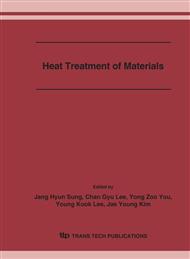p.201
p.209
p.215
p.221
p.227
p.235
p.243
p.247
p.257
The Effects of Probe Geometric Shape on the Cooling Rate Curves Obtained from Different Quenchants
Abstract:
In order to investigate the effects of probe geometric shape on cooling curves of quenchants, the ISO Inconel 600 alloy probe and a flat probe (Dimension: 120 mm × 120 mm × 20mm, phase-transformation free CrNi-steel) were both adopted to measure the cooling curves of oil, water and aqueous polymer quenchant. By comparing and analyzing the cooling rate curves measured by the two kinds of probes, it can be found that the shape of water and oil’s cooling rate curves obtained using different probes are almost same. While those for the aqueous polymer quenchant are not, especially at the initial cooling phase. During the initial cooling phase the cooling rate measured by the flat probe fluctuates in a narrow range, whereas this phenomenon couldn’t be seen while using the ISO Inconel 600 alloy probe. The reason could be contributed to the geometric shape difference of the two kinds of probes and the property of inverse solubility of the aqueous polymer quenchant. In order to illustrate the inverse solubility property of the aqueous polymer quenchants the probe geometric shape should be considered.
Info:
Periodical:
Pages:
227-232
Citation:
Online since:
December 2006
Authors:
Price:
Сopyright:
© 2006 Trans Tech Publications Ltd. All Rights Reserved
Share:
Citation:


